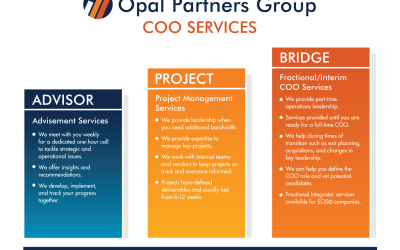Transformation takes effort. We see examples of it every day in the world around us. Let's take the butterfly as an example. The journey a butterfly takes from egg to caterpillar to butterfly is more fascinating that I ever realized.When it is time to change from...
INSIGHTS
Thoughts on strategy and operations from a Fractional COO
Good growth
Growth is good – until it isn’t. If you grow too fast, you can damage your brand, compromise your product, and burn out your team. Good growth is managed and planned. Let’s look again at a lesson from recent history. Toyota has long been recognized for their...
Turn ideas into reality
Business owners can be idea machines. Your business started as an idea, and ideas keep the business fresh and relevant. By themselves don’t accomplish anything unless you turn ideas into reality. Unless you can accomplish something by the stroke of a pen, you have...
Can you afford to grow? Can you afford not to?
Growth: Can you afford it? "Grow or die!" is a common, well-accepted business principal. Businesses must innovate, stay relevant, seek new customers, add locations, and offer new products. But growth brings its own challenges. You have more products/services to...
The Silver Bullet
Are you searching for a software solution that will transform your business? Or maybe your company is just one great hire from kicking it into another gear. Perhaps you are on the verge of implementing a new program rally your team. You are hoping for a silver bullet....
Growth: The Good, the Bad, and The Ugly
It’s a safe bet that if you do a quick internet search on business priorities that increasing topline revenue, improving sales performance, and increasing company value will show up in the top results. Growth matters. To misquote Gordon Gekko: growth is good. Growth...
Why? Why not?
These may be the two most important - and least-asked - questions. “Why?” makes you think about purpose. “Why not?” opens you up to new possibilities. Let’s start with why. The answer to this question identifies the reason behind a decision or an action. It is...
Gain more by giving away
“I’m too busy.” “I don’t have time.” “I have too many priorities fighting for my attention.” Sound familiar? In times where we are expected to do more with less and where immediate isn’t fast enough, we’ve all felt that way. It’s worse when we think we must do it all...
Your business is growing….why don’t you feel like you are winning?
Your business is growing. You've got a great product or service, you know your customers, and you've assembled a stellar team. But something has changed. Profitability has slipped, tasks take longer to complete than they should, or your team is frustrated. What's...
Ready to take your first step towards breaking through to a new level of performance?
Then let’s hop on a call and see if System & Soul is right for you.










